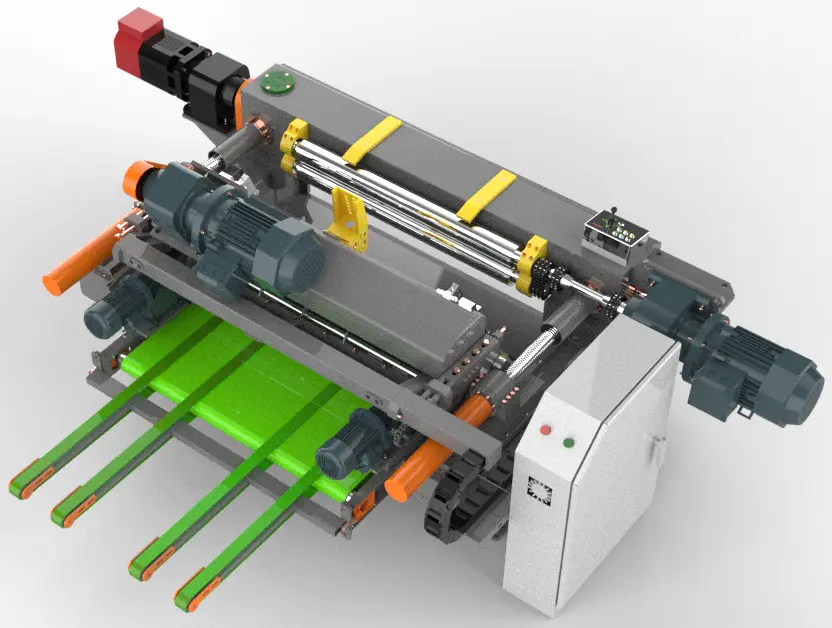For veneer production enterprises, ensuring continuous operation of equipment is fundamental to maximizing efficiency. However, even the highest-quality wood veneer peeling machine can experience malfunctions over time. Therefore, understanding common issues and resolving them quickly is crucial. This article will detail the common faults of wood veneer peeling machines and their solutions to help users troubleshoot problems efficiently and maintain smooth machine operation.
Common Issues and Solutions
1. Uneven Veneer Surface
Issue:
The veneer surface appears wavy or uneven after peeling.
Possible Causes:
- The knife blade is not straight or has uneven edges.
- The roller has excessive vibration, or the bearing is damaged.
- Excessive feed pressure is applied, causing wood deformation.
- The wood itself has significant density variations or is bent.
Solutions:
- Regrind the knife to ensure a sharp and straight cutting edge.
- Check and replace damaged bearings, adjust roller vibration.
- Adjust the feed pressure to prevent excessive force on the wood.
- Select high-quality wood and avoid using logs with significant density variations.
2. Uneven Veneer Thickness
Issue:
The veneer thickness is inconsistent, with noticeable variations.
Possible Causes:
- Incorrect knife position; the knife gap is too large or too small.
- A dull knife reduces peeling efficiency.
- The wood is too hard or too dry.
- Poor contact in the carbon brush of the electromagnetic clutch.
Solutions:
- Adjust the knife position and knife gap for even contact with the wood.
- Regrind or replace the knife to ensure sharpness.
- Use wood with appropriate moisture content; soak or steam if necessary.
- Check and adjust the carbon brush of the electromagnetic clutch for proper contact.
3. Uneven Residual Wood Core Diameter
Issue:
After peeling, the remaining wood core has different diameters at both ends, causing a fan-shaped veneer.
Possible Causes:
- The knife height is uneven at both ends.
- The single roller bearing is damaged.
- The knife carriage slide or guide rail screws are loose.
Solutions:
- Adjust the knife height on both ends to ensure uniformity.
- Replace the single roller bearing.
- Inspect and tighten the knife carriage slide and guide rail screws.
4. Periodic Variations in Veneer Thickness
Issue:
The veneer thickness fluctuates periodically during peeling.
Possible Causes:
- Significant density variation in the wood.
- The knife position is too high or too low.
- Excessive clearance in the single or double roller bearings.
Solutions:
- Adjust the knife height to ensure consistent contact with the wood.
- Replace worn-out single or double roller bearings.
5. Veneer Curling
Issue:
The peeled veneer curls or does not discharge smoothly.
Possible Causes:
- The knife gate is too narrow.
- The knife is positioned too high.
- The wood is too dry.
Solutions:
- Slightly widen the knife gate for smoother veneer output.
- Adjust the knife position to the optimal height.
- Lightly spray water on dry wood before peeling.
Routine Maintenance to Minimize Issues
To maintain optimal performance and extend the lifespan of the wood veneer peeling machine, regular maintenance is essential:
- Check the Knife Regularly: Ensure the knife remains sharp, and regrind or replace it when necessary.
- Inspect Bearings and Rollers: Regularly check for wear and replace damaged bearings.
- Keep the Machine Clean: Remove dust and wood debris frequently to ensure smooth operation.
- Lubrication and Tightening: Apply lubrication to moving parts and tighten loose bolts periodically.
Conclusion
Understanding common wood veneer peeling machine issues and their solutions is crucial for maintaining efficient production. With proper maintenance and timely troubleshooting, productivity can be improved, and machine lifespan extended. If complex problems arise, it is advisable to consult a professional technician for further inspection and repairs.


